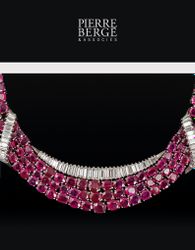
Madame G's jewellery box
Pierre Bergé & Associés - 01.49.49.90.00 - Email CVV
PLACE OF SALE
Pierre Bergé & associés
21 avenue Kléber 75016 Paris
PUBLIC EXHIBITION
Friday May 10 to Monday May 13
from 10am to 4pm
21 avenue Kléber, Paris XVIe
Viewing of nos. 29 and 31 is by appointment only.
Tel: (+33) 6 30 19 52 55
Mail: [email protected]
SALES CONTACT
T.+33 (0)1 49 49 00 90
LIEU DE VENTE
Pierre Bergé & associés
21 avenue Kléber 75016 Paris
EXPOSITION PUBLIQUE
Du vendredi 10 au lundi 13 mai
de 10h à 16h
21 avenue Kléber, Paris XVIe
Les n° 29 et 31 sont visibles exclusivement sur rendez-vous.
Tel : (+33) 6 30 19 52 55
Mail : [email protected]
CONTACT POUR LA VENTE
T.+33 (0)1 49 49 00 90
Exhibition of lots
Caution
Un dépôt de garantie sera demandé pour enchérir sur les lots n°29 et n°31. Veuillez prendre contact avec l'étude : [email protected] / 01 49 49 90 00
Frais de vente
Les acheteurs paieront en sus de l'adjudication par lot des frais de 30% TTC
Aucun frais additionnel ne sera facturé pour les adjudication provenant des plateformes d'enchères Live.
Les droits de suite éventuels sont à la charge de l'acheteur.
Règlement
Paiement au comptant dans un délai de 7 jours.
Tout bordereau d'adjudication demeurant impayé auprès de la Maison de ventes ou ayant fait l'objet d'un retard de paiement entrainera le signalement de l'acheteur défaillant auprès de Drouot.
Délivrances
Les lots sont à retirer au 21 avenue Kléber - 75116 Paris, du lundi au samedi 9h-12h et 14h-18h, en respectant un délai de prévenance de 24 heures.
Les lots vendus sont stockés gracieusement pour une durée de 15 jours civils à l'issue de la vente. Des frais de stockage seront ensuite facturés.
Passé 15 jours civils, il sera facturé un montant forfaitaire de 20€ par bordereau.
Passé 30 jours civils, il sera facturé un montant de 5€ par jour et par lot.
Aucun lot ne sera délivré jusqu'au paiement intégral et effectif du bordereau et le cas échéant des frais de stockage.
Expéditions
Les acheteurs peuvent faire appel au transporteur Enchères Expédition
[email protected] / 03 58 23 01 00 ou à tout autre prestataire de son choix.
Nous ne sommes pas habilités à réaliser vos envois et déclinons toute responsabilité dans la livraison et l'expédition effectué par un prestataire tiers.